| THIS WEEK'S ARTICLES |
| The Market Message |
| There's a Reason Why Banks and Energy Stocks are Falling Together - And That Reason May be Falling Oil Prices |
| by John Murphy |
Editor's Note: This article was originally published in John Murphy's Market Message on Friday, May 31st at 11:14am ET.
Energy stocks are one of the weakest parts of the market. So are bank stocks. There may be a reason why. The black bars in Chart 7 shows the Energy SPDR (XLE) trading at the lowest level in five months. The green bars show the KBW Bank Index trading below both moving average lines, and nearing a test of its March low. There may be a reason why both groups have been doing worse than the rest of the market over the last month. And that has to do with low inflation and the price of oil. The price of crude oil has fallen nearly -20% since the end of April. Which is the main reason that energy stocks have been weak. Falling oil prices also weaken the inflation outlook, which is one of the factors pulling bond yields lower. Falling bond yields, in turn, are hurting bank stocks.
Chart 7
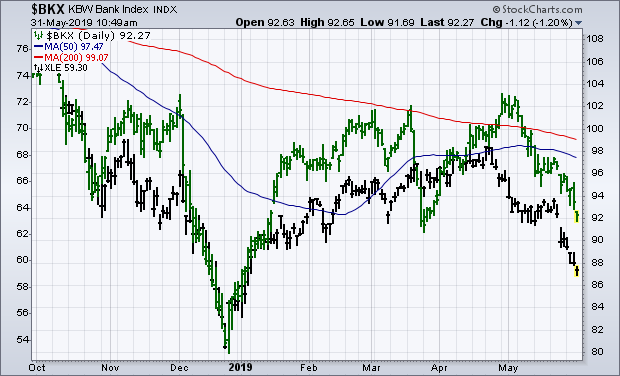
|
| READ ONLINE → |
|
|
|
| Market Roundup |
| Current Trend of Declining Rates Seen as Part of a Large Base |
| by Martin Pring |
Editor's Note: This article was originally published in Martin Pring's Market Roundup on Friday, May 24th at 4:42pm ET.
This week has seen many interest rate series, both in the US and around the world, breaking down from important trading ranges or reaffirming previous breaks. It seems that the bond market is responding to the recent trend of lower commodity prices. In retrospect, that rangebound action, along with any further drop in yields in the period ahead, is likely to turn out to be part of a larger trading range, the upside resolution of which will ultimately signal the next secular uptrend. In short, I am expecting any downside action to be of limited scope and not to register new secular lows.
This possibility is captured by the 3-year yield, featured in Chart 1 below. Here, we can see the secular downtrend that took place between 1981 and 2012. Note that, last year, the yield once again found resistance at its secular downtrend line. Downside reversals in the KST have historically been followed by a primary trend decline; last year’s signal was no exception. In the case of the 3-year maturity, it looks as though the yield completed and broke out from a base pattern in late 2016. That means that any decline in its yield from here on out is likely to represent a retracement to the top of the 2010-2017 pattern.
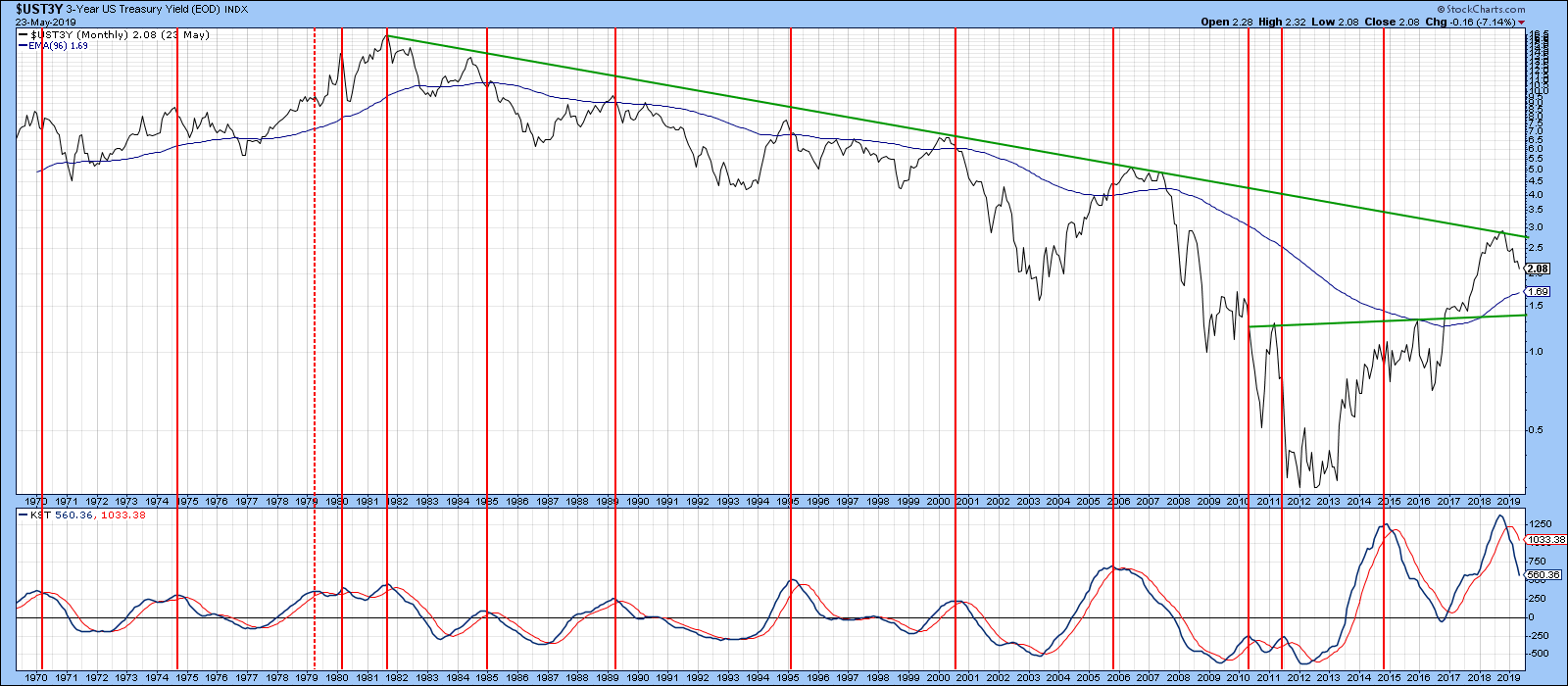 Chart 1 Chart 1
Chart 2 moves further down the yield curve to more realistically feature an unresolved trading range, which has been highlighted in blue. Note that the KST is still declining and still at a moderately overbought reading. As this momentum indicator works its way lower, I am expecting rates to do the same. When an upside KST reversal does materialize, it is likely to signal another assault on the secular downtrend line for both this and the 3-year maturity in Chart 1.
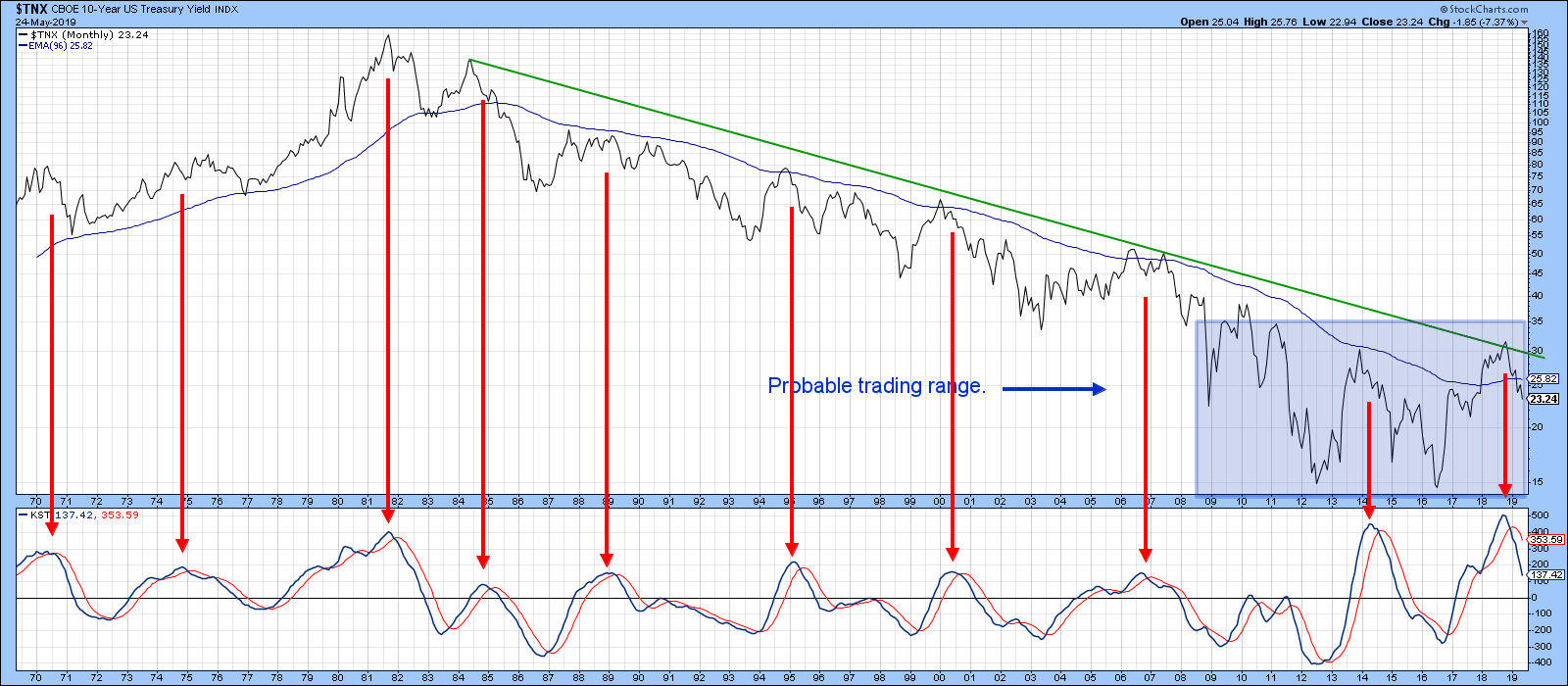 Chart 2 Chart 2
Good luck and good charting,
Martin J. Pring
The views expressed in this article are those of the author and do not necessarily reflect the position or opinion of Pring Turner Capital Group of Walnut Creek or its affiliates.
|
| READ ONLINE → |
|
|
|
| Art's Charts |
| Key Moving Average Rolls Over for S&P 500 |
| by Arthur Hill |
 The 200-day moving averages for the S&P Mid-Cap 400 and the S&P Small-Cap 600 are already trending lower and this key moving average for the S&P 500 turned lower over the past week. This puts all three indexes below their falling 200-day SMAs and in potential downtrends. The 200-day moving averages for the S&P Mid-Cap 400 and the S&P Small-Cap 600 are already trending lower and this key moving average for the S&P 500 turned lower over the past week. This puts all three indexes below their falling 200-day SMAs and in potential downtrends.
Chartists can use moving averages to determine the trend in at least two ways. First, the trend is up when price is above the moving average and down when price is below the moving average. The chart below shows $SML breaking its 200-day SMA on May 7th. $MID followed suit with a move below on May 22nd and $SPX closed below the 200-day on May 31st.
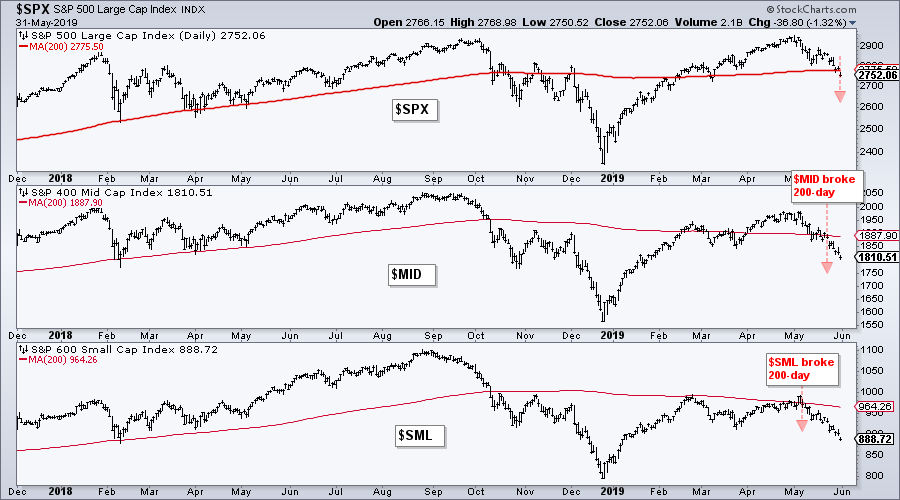 Chartists can also use the direction of the moving average to determine trend. A rising moving average indicates an uptrend, while a falling moving average signals a downtrend. Moving average direction is not always easy to determine. Sometimes we need to remove the price bars and shorten the timeframe to see more detail. The chart below focuses on the moving averages by making the price bars invisible. Click the chart to open it and see the SharpChart settings. Chartists can also use the direction of the moving average to determine trend. A rising moving average indicates an uptrend, while a falling moving average signals a downtrend. Moving average direction is not always easy to determine. Sometimes we need to remove the price bars and shorten the timeframe to see more detail. The chart below focuses on the moving averages by making the price bars invisible. Click the chart to open it and see the SharpChart settings.
 Notice that the 200-day SMAs for the S&P Mid-Cap 400 and S&P Small-Cap 600 have been falling since March and continued their fall in May. In contrast, the 200-day SMA for the S&P 500 rose from March to mid May and then turned lower over the last five days. With the SMA for the S&P 500 turning lower, all three indexes are now below their falling 200-day SMAs and in long-term downtrends. Notice that the 200-day SMAs for the S&P Mid-Cap 400 and S&P Small-Cap 600 have been falling since March and continued their fall in May. In contrast, the 200-day SMA for the S&P 500 rose from March to mid May and then turned lower over the last five days. With the SMA for the S&P 500 turning lower, all three indexes are now below their falling 200-day SMAs and in long-term downtrends.
On Trend on Youtube (Thursday, 30-May)
- SPY: Oversold at 200-day SMA
- New Lows Expand (Indexes and Sectors)
- Several Semis are Oversold at Support
- A New Play on Palladium?
- Click here to Watch.
On Trend on Youtube (Tuesday, 28-May)
- Walking Down the Lower Bollinger Band
- Sectors Above/Below 200-Day SMA
- Focus on XLV and Healthcare Stocks
- Breakdowns in Industrial and Discretionary Stocks
- FAAAM+: FB, AMZN, AAPL, GOOGL, MSFT (+NFLX).
- Click here to Watch
Arthur Hill, CMT
Senior Technical Analyst, StockCharts.com
Author, Define the Trend and Trade the Trend
Want to stay up to date with the latest market insights from Arthur?
– Follow @ArthurHill on Twitter
– Subscribe to Art's Charts
– Watch On Trend on StockCharts TV (Tuesdays / Thursdays at 10:30am ET)
|
| READ ONLINE → |
|
|
|
| The Mindful Investor |
| Five Trendlines Revisited |
| by David Keller |
About a month ago, I wrote an article for ChartWatchers titled “Five Trendlines You Should Be Watching.” The general idea was that, as long as those five trend lines held, then the market was still most likely in a very constructive phase.
Revisiting those trend lines here will show that the picture has changed dramatically in just four weeks, presenting a more bearish outlook for the equity markets.
1) Nasdaq 100 Index
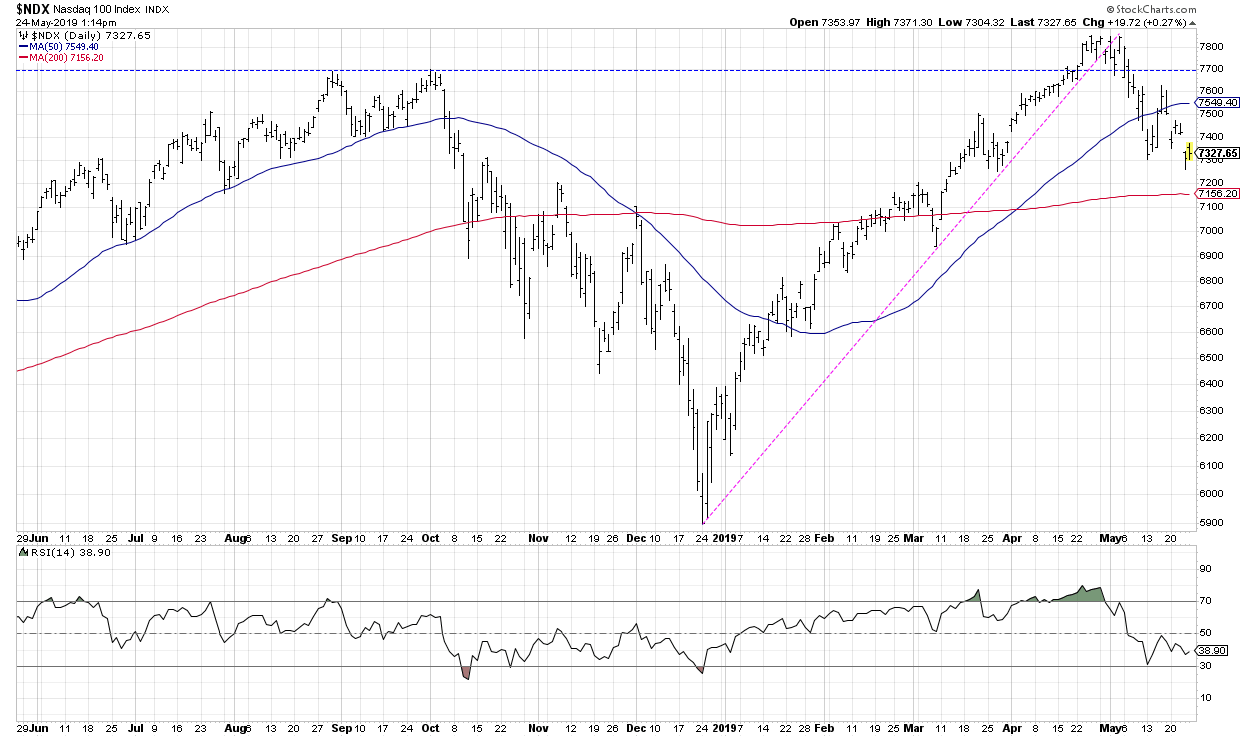 This was a key chart for me, as it represented the mega cap technology leadership that drove the market higher in the first four months of 2019. This trend line break was the most important in terms of acknowledging a potential sea change within equities. This was a key chart for me, as it represented the mega cap technology leadership that drove the market higher in the first four months of 2019. This trend line break was the most important in terms of acknowledging a potential sea change within equities.
2) Semiconductors
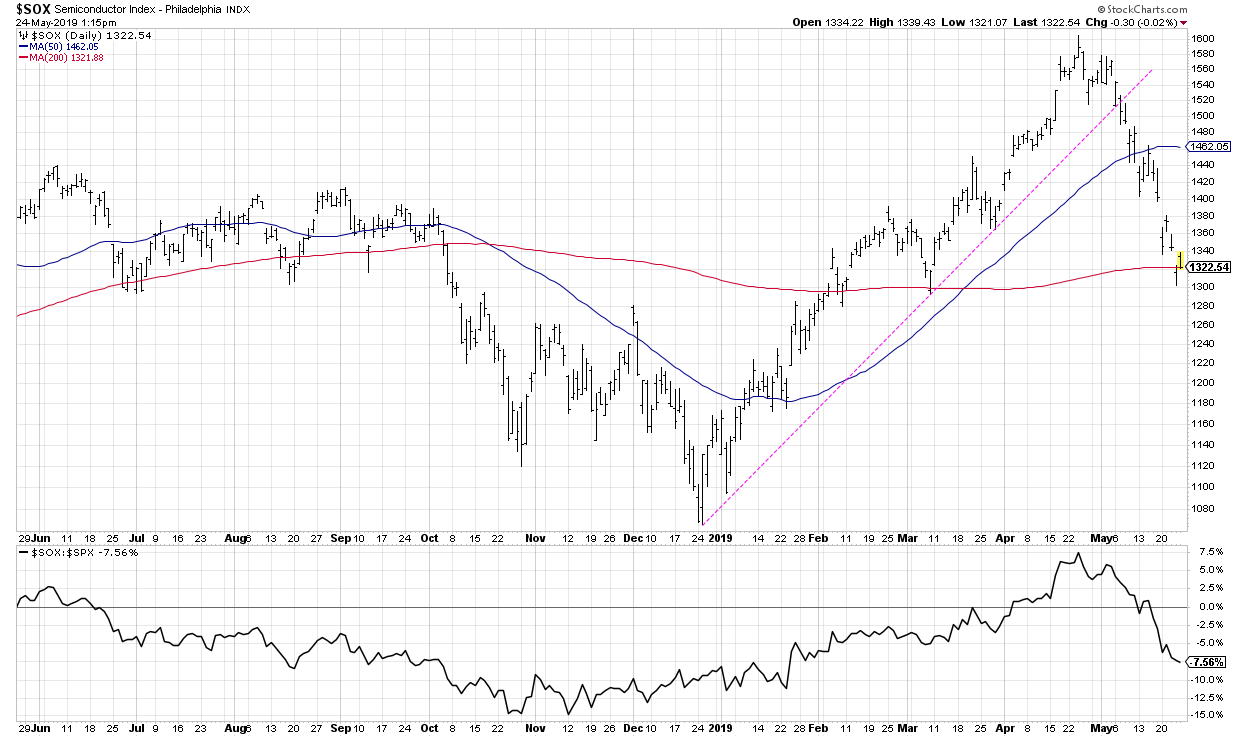 The market has rarely gone meaningfully higher without semiconductors participating in the upswings. The SOX has broken trend line support and is now testing the 200-day moving average around 1320. A confirmed break below 1300 would suggest further lows and underperformance. The market has rarely gone meaningfully higher without semiconductors participating in the upswings. The SOX has broken trend line support and is now testing the 200-day moving average around 1320. A confirmed break below 1300 would suggest further lows and underperformance.
3) Microsoft
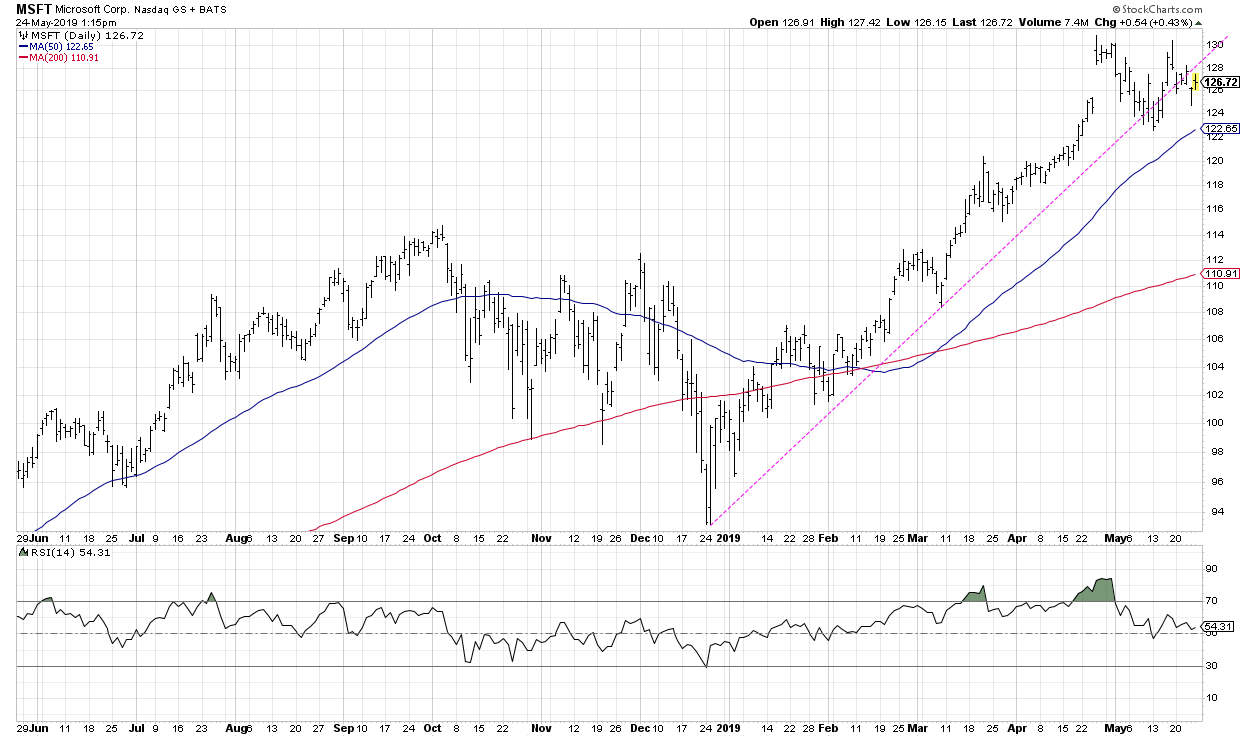 Microsoft is perhaps the least painful of the bunch, as it has broken the trend line a number of times but hasn’t really confirmed the break yet. Microsoft is perhaps the least painful of the bunch, as it has broken the trend line a number of times but hasn’t really confirmed the break yet.
To confirm a trend line break, I usually look for a close through the trend line, followed by confirmation when the price moves even further in the direction of the breakout. This suggests that any resistance to the move has been overwhelmed and the price is likely to continue in the direction of the breakout.
It’s also worth noting that Microsoft remains the largest company in the world by market cap. The fact that MSFT has not confirmed a downside breakout is one of the reasons why charts like the SPX don’t look nearly as bad as they could.
4) Amazon
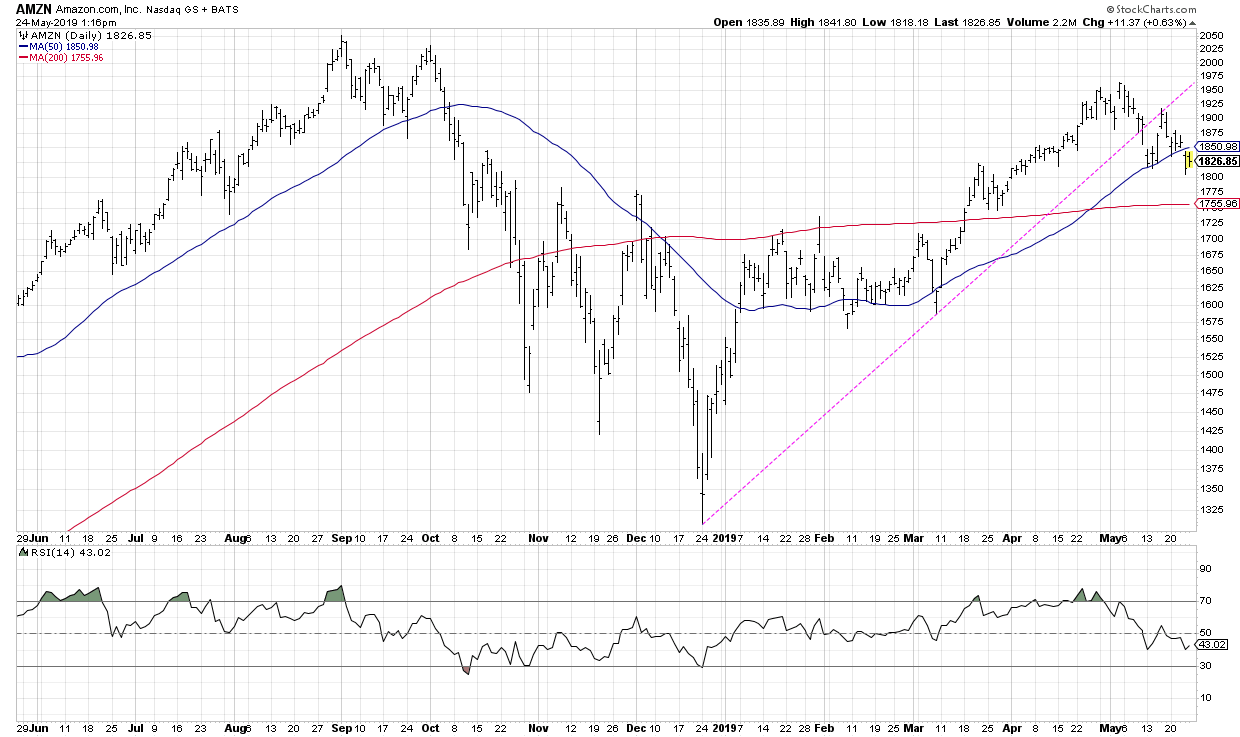 Amazon has now confirmed a downside break of trend line support and is in the process of violating the 50-day moving average as well. The 200-day moving average looms large at around 1750. Amazon has now confirmed a downside break of trend line support and is in the process of violating the 50-day moving average as well. The 200-day moving average looms large at around 1750.
5) Offense vs. Defense
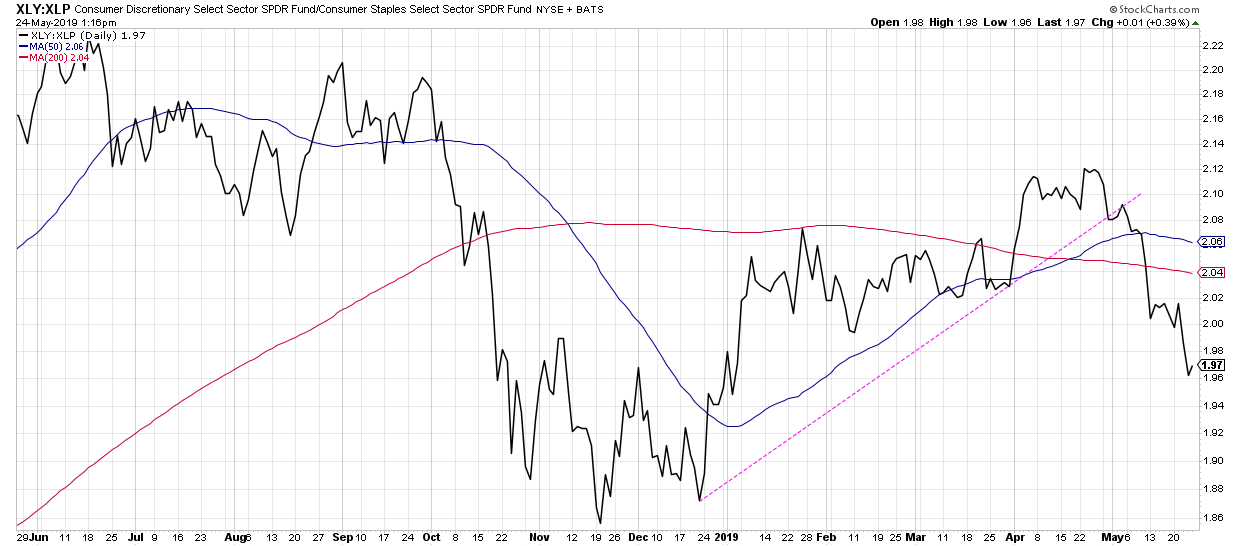 I love to use this ratio as a barometer of risk on vs. risk off within the consumer space. The ratio has confirmed a breakdown of the trend line and is now in an established downtrend. This suggests a rotation more toward the defensive side of the consumer sectors. I love to use this ratio as a barometer of risk on vs. risk off within the consumer space. The ratio has confirmed a breakdown of the trend line and is now in an established downtrend. This suggests a rotation more toward the defensive side of the consumer sectors.
It’s worth noting that I actually included a sixth trend line in the original article, using a chart of bond prices in the form of the AGG ETF.
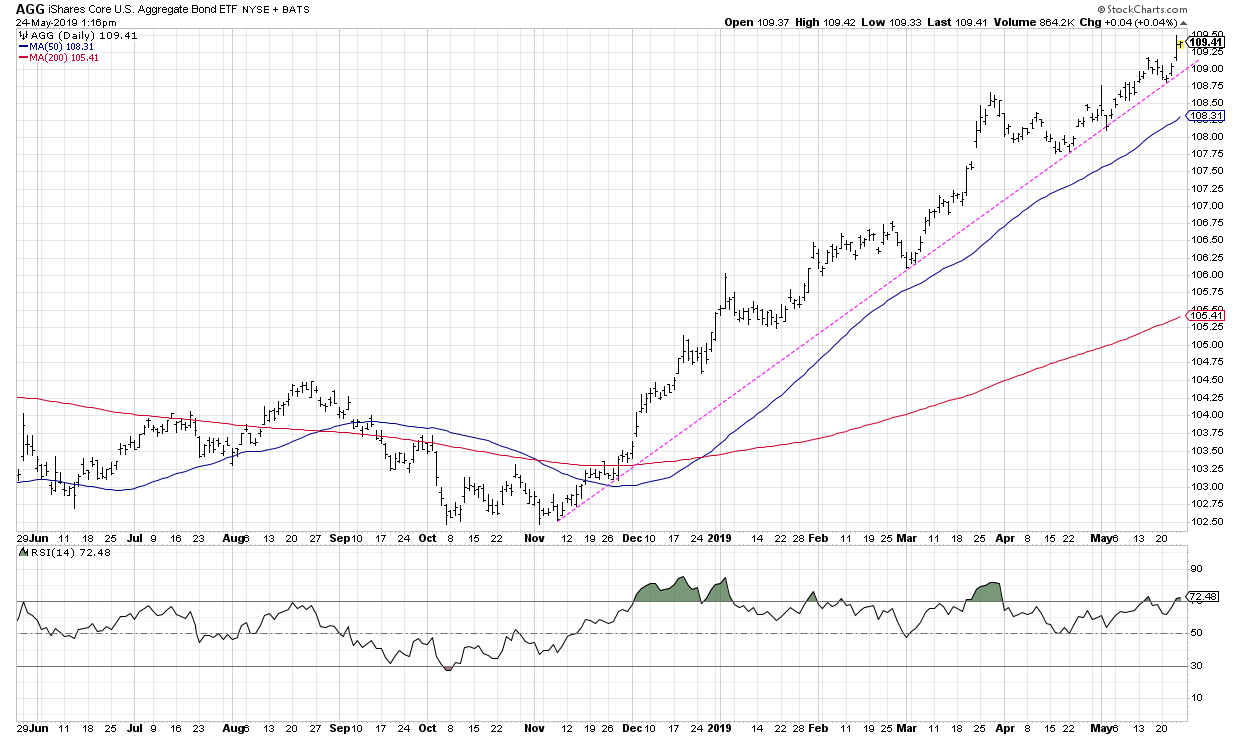 I added this chart to the article in a later version because, although it represented a very different market than the other five charts, it was still a chart in a consistent uptrend that deserved attention. I added this chart to the article in a later version because, although it represented a very different market than the other five charts, it was still a chart in a consistent uptrend that deserved attention.
Not surprisingly, this is the one trend line that has actually remained unbroken during the recent market turmoil. Bonds remain in a cyclical bull market and continue to run higher unabated. Charts like AGG have become overbought numerous times over the last six months, but, in each instance, the chart has continued higher.
At some point, that pattern of higher highs and higher lows will break. A violation of trend line support is what may finally signify that the cyclical bull market in bonds is over. Until then, the trend is up!
RR#6,
Dave
David Keller, CMT
President, Sierra Alpha Research LLC
Disclaimer: This blog is for educational purposes only and should not be construed as financial advice. The ideas and strategies should never be used without first assessing your own personal and financial situation or without consulting a financial professional.
The author does not have a position in mentioned securities at the time of publication. Any opinions expressed herein are solely those of the author and do not in any way represent the views or opinions of any other person or entity.
|
| READ ONLINE → |
|
|
|
| The Canadian Technician |
| Gold - Something To Love? |
| by Greg Schnell |
As I have mentioned in the last three Market Roundup shows (which you can find here on the StockCharts YouTube channel), the Gold-related charts have been setting up for weeks now. Friday's price action to close out the month looks like an initiation move that has more room to run. While that is hard to call on the first few days, the move was a very significant one at an important zone on the charts.
Focusing in on price, Gold has been able to hold above the 40-week moving average since the December move where price originally crossed up above it. Gold also finished at the top of the weekly price bar for the first time since February, its highest close since mid-March. There are not many asset classes in equities or commodities that finished the past week at the top of the price bar for the first time in months. Another bullish perspective is that the PPO turned up (without crossing the signal line) while above zero. In two past instances where it has crossed the signal line while above zero, the price rallied for at least a couple of months. Next week, we'll see if the price holds here as well as if the PPO finishes crossing above the signal line, as that has not happened yet. The bullish pattern is set up, but we'll need to see it play out.
The relative strength (shown in purple) is at a 3-month high for the first time since last year. Typically, that is a positive signal, as the relative strength is making higher highs ahead of price. One of the first signals on a weekly chart will be a move on the stochastics above 20, which also happened Friday.
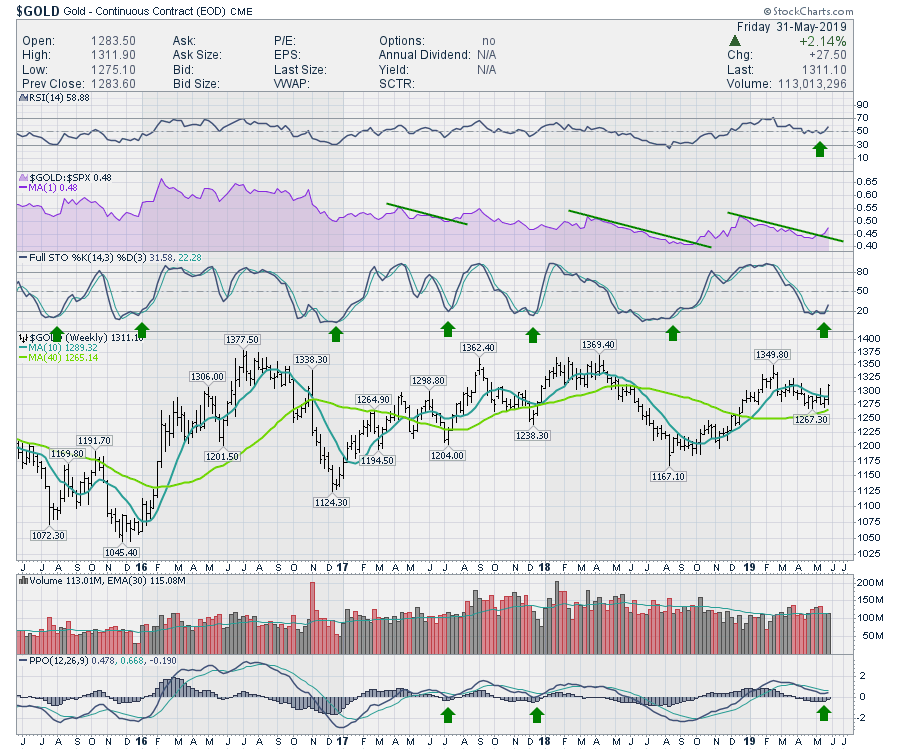 One of the big clues regarding Gold is how well the miners outperformed the Gold price to finish the week. Gold was up 1.3% Friday, but the miners were up 3.9%, which was triple Gold's performance for the day. There are also a couple of other things on this chart that make it interesting. On the left side of the chart, the SCTR was never above 75. After surging up above 75 and going on a run, the gold miners gently pulled back and the SCTR dropped under 10. After a brief period down at 10, the SCTR has now surged back to become one of the top performing ETFs. This change in behavior compared to other stocks is important and is one of the gems that shows up in the SCTR indicator. While the relative strength did not make new three-month highs, it did pop up to new one-month highs. I'll be watching for that to keep outperforming next week. One of the reasons we have been watching Gold on Market Roundup is that the volume was getting extremely low. I have drawn a horizontal line at the May 21st volume level and May 20th was also low. Comparing that level by looking left, this was the lowest volume on the chart, including half-days around Thanksgiving and Christmas. When the volume goes eerily quiet, the behavior is changing. One of the big clues regarding Gold is how well the miners outperformed the Gold price to finish the week. Gold was up 1.3% Friday, but the miners were up 3.9%, which was triple Gold's performance for the day. There are also a couple of other things on this chart that make it interesting. On the left side of the chart, the SCTR was never above 75. After surging up above 75 and going on a run, the gold miners gently pulled back and the SCTR dropped under 10. After a brief period down at 10, the SCTR has now surged back to become one of the top performing ETFs. This change in behavior compared to other stocks is important and is one of the gems that shows up in the SCTR indicator. While the relative strength did not make new three-month highs, it did pop up to new one-month highs. I'll be watching for that to keep outperforming next week. One of the reasons we have been watching Gold on Market Roundup is that the volume was getting extremely low. I have drawn a horizontal line at the May 21st volume level and May 20th was also low. Comparing that level by looking left, this was the lowest volume on the chart, including half-days around Thanksgiving and Christmas. When the volume goes eerily quiet, the behavior is changing.
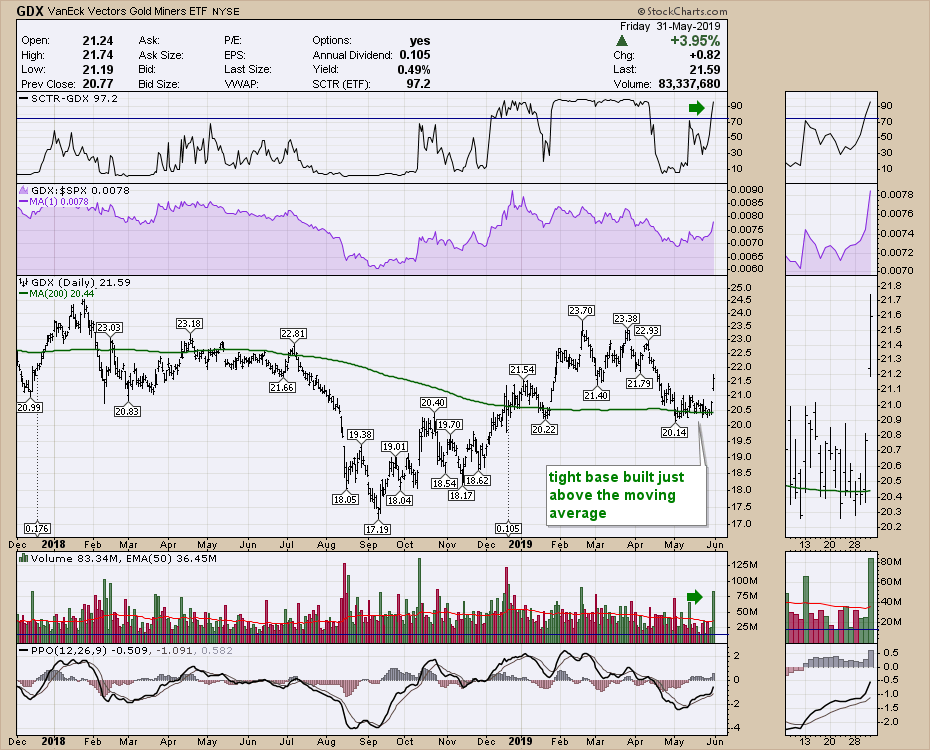 From my Market Roundup charts, we can see what the volume profile looked like on GLD. Three of the last five weeks had the lowest volumes in three years! While we don't know how that will play out, it definitely suggests watching for a potential trend change. From my Market Roundup charts, we can see what the volume profile looked like on GLD. Three of the last five weeks had the lowest volumes in three years! While we don't know how that will play out, it definitely suggests watching for a potential trend change.
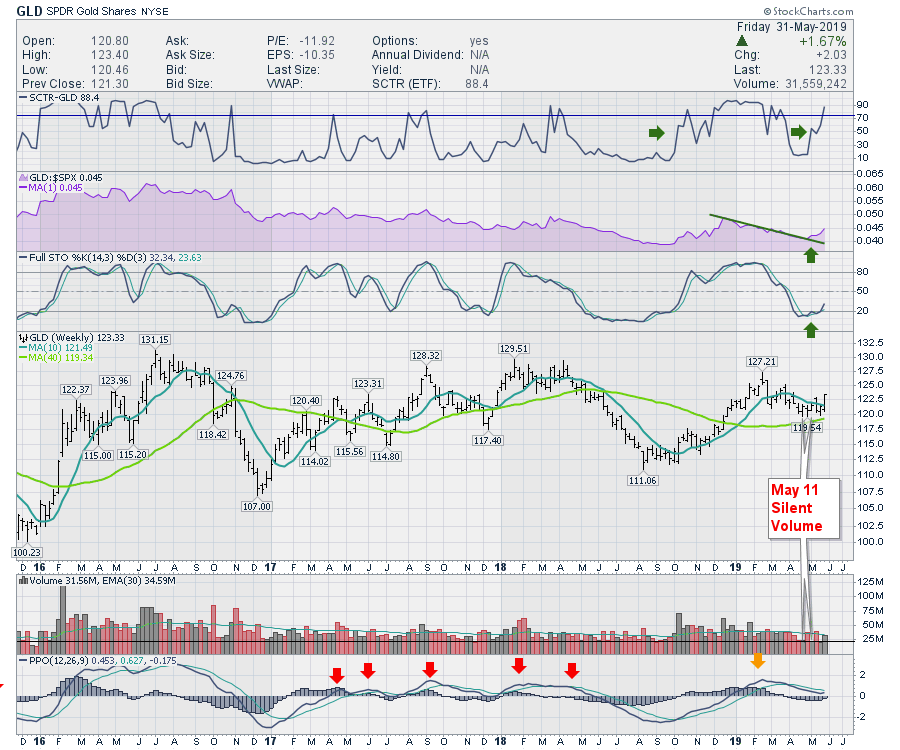 As Gold appears to be one of the bright spots this week, I'll have more information on the gold and silver setup in my Market Roundup on Saturday evening on the StockCharts YouTube channel. There are numerous other charts that I have been following to confirm the move in gold that ramped up as well. This bullish setup definitely looks promising for GDX and GLD. I would buy the miners more than the metal, as they tend to move farther and faster. I will work through the gold mining stocks on the video to point out which ones are set up nicely right now. As Gold appears to be one of the bright spots this week, I'll have more information on the gold and silver setup in my Market Roundup on Saturday evening on the StockCharts YouTube channel. There are numerous other charts that I have been following to confirm the move in gold that ramped up as well. This bullish setup definitely looks promising for GDX and GLD. I would buy the miners more than the metal, as they tend to move farther and faster. I will work through the gold mining stocks on the video to point out which ones are set up nicely right now.
Good trading,
Greg Schnell, CMT, MFTA
Senior Technical Analyst, StockCharts.com
Author, Stock Charts For Dummies
Want to stay on top of the market's latest intermarket signals?
– Follow @SchnellInvestor on Twitter
– Connect with Greg on LinkedIn
– Subscribe to The Canadian Technician
|
| READ ONLINE → |
|
|
|
|
|
| Trading Places |
| Calling Market Tops Is Easier Than You Think |
| by Tom Bowley |
There are no perfect signals that scream "GET OUT" of equities, but there are warning signs.....so long as you know where to find them. Most market participants believe in the random walk theory, which suggests that changes in stock prices have the same distribution and are independent of each other. Therefore, the assumption is that past stock market movements or trends cannot be used to predict its future movement.
I beg to differ.
Sentiment swings back and forth. I think if we're all honest with ourselves, we know that we generally grow overly bullish and overly bearish the stock market at just the wrong times. It's human nature. Don't beat yourself up, it happens to us all. But what if there was a mechanism to signal when sentiment was heading too far in one direction or the other?
There is and it's called the Volatility Index ($VIX). Here's the CBOE's explanation of the VIX and how it's calculated:
"The VIX Index is a financial benchmark designed to be an up-to-the-minute market estimate of expected volatility of the S&P 500 index, and is calculated by using the midpoint of real-time S&P 500 index option bid/ask quotes. More specifically, the VIX Index is intended to provide an instantaneous measure of how much the market thinks the S&P 500 Index will fluctuate in the 30 days from the time of each tick of the VIX Index."
On the charts, the VIX rises as the S&P 500 declines. That's the normal relationship and it's illustrated here:
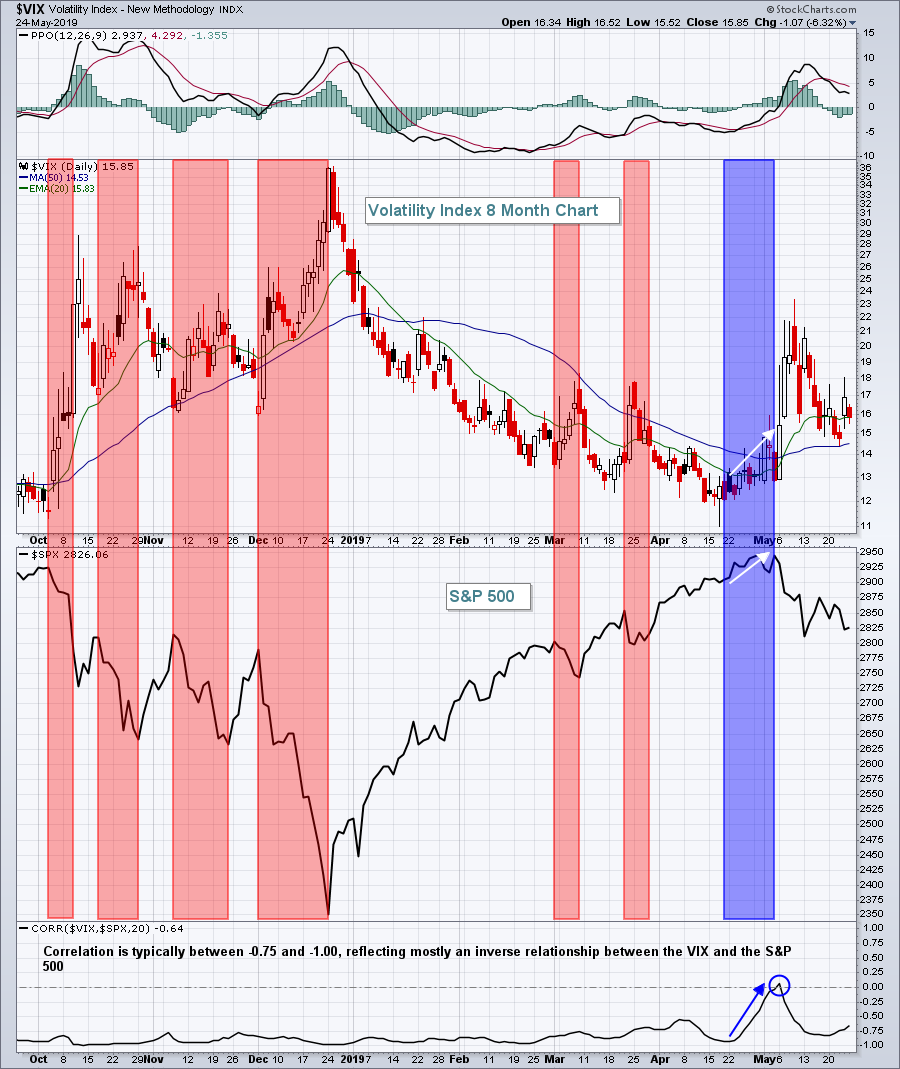 The red-shaded areas highlight the fact that the VIX rises significantly when the S&P 500 declines. When the S&P 500 rises, volatility diminishes. Hence, the correlation readings that are at or near -1.00 throughout much of the period above. The part that was interesting, however, was the blue-shaded area. At the last high on the S&P 500 in early May, the VIX was already on the rise! Correlation was already turning positive. Should we consider this as a potential warning sign of a top? Let's go back in time and see how often this signal is triggered and what the after-effect was: The red-shaded areas highlight the fact that the VIX rises significantly when the S&P 500 declines. When the S&P 500 rises, volatility diminishes. Hence, the correlation readings that are at or near -1.00 throughout much of the period above. The part that was interesting, however, was the blue-shaded area. At the last high on the S&P 500 in early May, the VIX was already on the rise! Correlation was already turning positive. Should we consider this as a potential warning sign of a top? Let's go back in time and see how often this signal is triggered and what the after-effect was:
 What do you think? I think this signal is a keeper! When the stock market is rising and the VIX is rising simultaneously, it's telling us the market is getting nervous. And when the market is nervous, we should be nervous! Of those seven signals, six gave us very solid warnings that we were going to see a drop. Keep in mind, these signals don't suggest we're entering a bear market. They simply tell us that the market is getting nervous and that we should consider moving some or all of our portfolio to cash or perhaps move to defensive sectors from aggressive sectors. What do you think? I think this signal is a keeper! When the stock market is rising and the VIX is rising simultaneously, it's telling us the market is getting nervous. And when the market is nervous, we should be nervous! Of those seven signals, six gave us very solid warnings that we were going to see a drop. Keep in mind, these signals don't suggest we're entering a bear market. They simply tell us that the market is getting nervous and that we should consider moving some or all of our portfolio to cash or perhaps move to defensive sectors from aggressive sectors.
I've discussed market bottoms on many occasions and I'm planning to do so again on Tuesday at 4:30pm EST in a FREE joint webinar with John Hopkins, President of EarningsBeats.com. Spotting market bottoms is based on two different sentiment indicators that are remarkably accurate. Join us on Tuesday and I'll show you how I do it. CLICK HERE to register.
Happy trading!
Tom
|
| READ ONLINE → |
|
|
|
| Earnings Beats |
| Strong Earnings can Fuel a Portfolio |
| by John Hopkins |
The market has been under fire for some time now as uncertainty abounds. Even a lot of stocks that had earlier reported strong earnings haven't been able to escape the recent market turmoil. However, there are also many stocks that have held up quite well, outperforming the market and reminding us that strong earnings DO matter.
As an example, we recently conducted a webinar that included unveiling 30 stocks we felt could outperform the market. These included 10 aggressive stocks, 10 "Model portfolio" stocks and 10 income/dividend stocks. 8 trading days later, the stocks have not disappointed, showing the following results through last Thursday's close:
- Aggressive portfolio - Beating SPX by 4.2%
- Model portfolio - Beating SPX by 3.62%
- Income/dividend portfolio - Beating SPX by 1.52%
Of course, 8 days is not a long enough timeframe to come to any major conclusions. However, in going back to November of last year, when we unveiled our "Top 10 Stocks," as well as May 10, just before we unveiled the latest batch of stocks, the Model portfolio was higher by almost 35%, while the S&P was higher by just over 7% during the same period of time.
I'm pointing all of this out to show that strong earnings can make a big difference no matter the market environment. Why? Because traders are attracted to companies that come up big (and why wouldn't they be?).
One thing we've done lately at EarningsBeats is reformat our "EarningsBeats Digest," which focuses on stocks with strong earnings. Friday's edition included a case study on Veeva Systems (VEEV), a stock that has performed well all year - including this past week when it released its numbers, as you can see below. This latest edition also includes a link to a recording of a webinar conducted last week, featuring StockCharts.com's Senior Technical Analyst Tom Bowley, on "What to look for in a Market Bottom." Talk about timely! If you would like to start receiving this FREE EarningsBeats Digest (including Friday's edition with the Market Bottom recording) just click here.
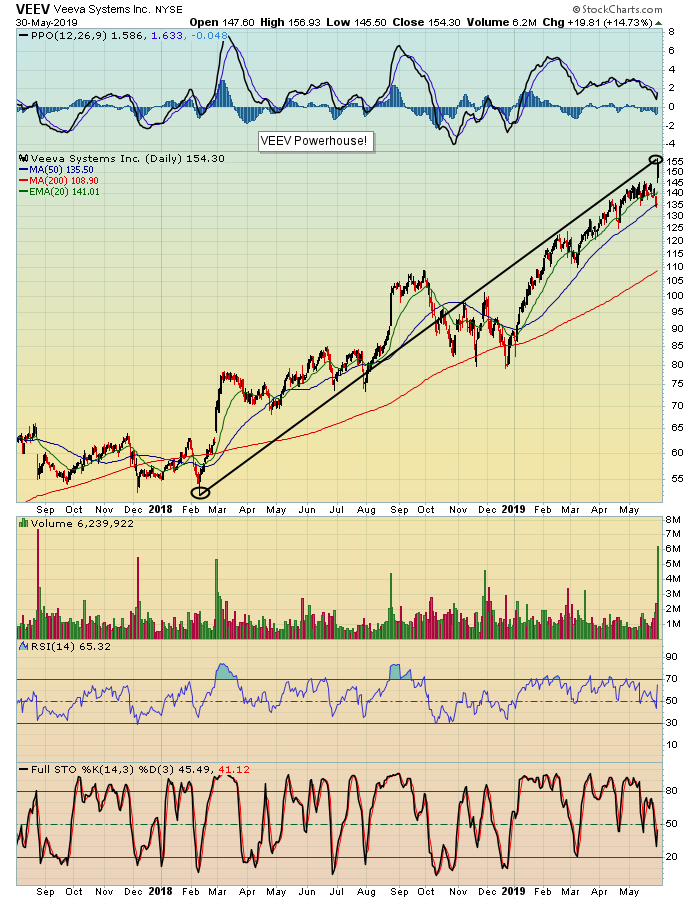 The market could remain highly volatile and, if it does, you will want to focus on stocks that are making money and headed higher for the future. These are the types of stocks traders are attracted to and should outperform the pack. The market could remain highly volatile and, if it does, you will want to focus on stocks that are making money and headed higher for the future. These are the types of stocks traders are attracted to and should outperform the pack.
At your service,
John Hopkins
EarningsBeats
|
| READ ONLINE → |
|
|
|
| SPECIAL EVENT ANNOUNCEMENT |
| For those of you in or near the Pacific Northwest – or anyone up for a trip to Seattle – we have an important announcement for you. The MoneyShow will be returning to Seattle next month, June 15th and 16th. In addition to a long list of incredible presenters, our own Gatis Roze will be a featured speaker at the event. Many of the StockCharts team members will be there as well, and we encourage you to join us. With so many experts sharing their investing wisdom and unique energy that accompanies this exciting event, we know it will be a can't-miss for 2019. Click the banner below to learn more and pre-register for next month's MoneyShow here in Seattle! |
 |
| LEARN MORE → |
|
| The Traders Journal |
| The Best of Breed Methodology: Stage 4 - A Significant Enhancement |
| by Gatis Roze |
 A quarter century of investing yields one paramount conclusion. Venture capitalists have known this forever. Professional sports teams as well. Investors have been a little slower on the uptake. A quarter century of investing yields one paramount conclusion. Venture capitalists have known this forever. Professional sports teams as well. Investors have been a little slower on the uptake.
Venture capitalists will tell you that if you invest in one company like Netflix, Salesforce or Google, it will make up for an awful lot of losers. The New England Patriots know that drafting one Tom Brady in 2000 is why they have won six Super Bowls. Similarly, I can attest to the fact that as an investor all these years, my two main concerns were not hitting a grand slam stock pick or making zillions of dollars. I’ve said this before — if your paramount focus with investing is to pick the next Google and make millions, you’ll underachieve.
My two main concerns were always (1) to minimize my risks and (2) to acknowledge that single base hits are okay. No need to swing for the fences. Having said that, along the way, I bought stocks like Amazon, Microsoft, Visa and Mastercard — to which I held on for an exhilarating ride that paid for all my losers many times over. My point being, they happened in the normal course of business.
But these “Ten Baggers”, as Peter Lynch use to call them, don’t just walk up to you and knock at your door. It takes a lot of base hits for you to eventually hit a couple out of the park. This blog is about making certain that you have a system to regularly get on first base — which will make it possible for you to occasionally get some of those “out of the park” hits.
I should add that this best of breed approach works equally well for stocks, ETFs and mutual funds. Don’t try to tell me that individual stocks are the only way to hit it out of the park. My T. Rowe Price (PRGTX) has outperformed the market by 300% and Prime Cap Odyssey (POAGX) has outperformed by 200% which is still out of the park. Many of my readers and students have told me that my “Best of Breed” methodology is a dependable profit enhancer. I can assure you it has been for me.
To get the “Full Monty” or the most benefit from this blog, I’m going to ask you to do a little refresher course on the “Best of Breed” methodology. I’ve written three previous blogs on various aspects. Consider the prior three blogs as Stage 1, Stage 2 and Stage 3. This blog enters new expanded enhanced territory so we’ll consider this to be Stage 4. Please review Stage 1, Stage 2, and Stage 3.
Stage 4:
This Stage 4 enhancement came about from two ongoing frustrations and challenges with the “Best of Breed” methodology, as it previously existed:
- Even as a “pro” user on StockCharts.com, I could only plot ten symbols on one performance chart.
- I was constantly checking out potential new dance partners (i.e. equities) that were presented to me by other investors, the media, Morningstar, ETF.com, etc. I wanted some way to archive the fact that I had indeed checked out candidate “X” even though at the time it was not found worthy of being included in my “Best of Breed” chart (with a limit of 10 candidates). But I did want to include it in future analysis. I also wanted a way to know that a year ago, for example, I had actually considered it for inclusion. Yes, I had installed many such candidates in the notes section below each asset class chart, but that was less effective and somewhat cumbersome.
What I’ve done now is something I call “Stage 4” which works nicely. I have created a separate ChartList. I’ll use the Emerging Markets asset class as my example. I have a ChartList — 10.0 — which consists of the twenty asset classes in which I actively invest.
In the Tensile Trading ChartPack, ChartList 10.07 holds charts of all 59 asset classes from our book where we reduced the thousands of crazy asset classes out there and distilled them down to the essential 59 global asset classes. In my 10.0 ChartList, the Emerging Markets chart is labeled #34 and it looks like this. Remember, I can only plot ten symbols.

With Stage 4, I’ve installed a new ChartList 335-34 Emerging Markets, and in it, I’ll find all the candidates I’ve considered in the past as well as my present ten candidates. Adding a ticker symbol to this ChartList is quick and easy, and because it is now archived, I can reconsider it once again sometime in the future. I also don’t waste my time re-evaluating the same ticker in three months since it’s already in the ChartList and failed to make the grade. I also don’t lose a potential winner that came to my notice previously.
So with space constraints vaporized, I can archive all the Emerging Markets ETFS and mutual funds that I’ve researched so that I can revisit them easily at any time.
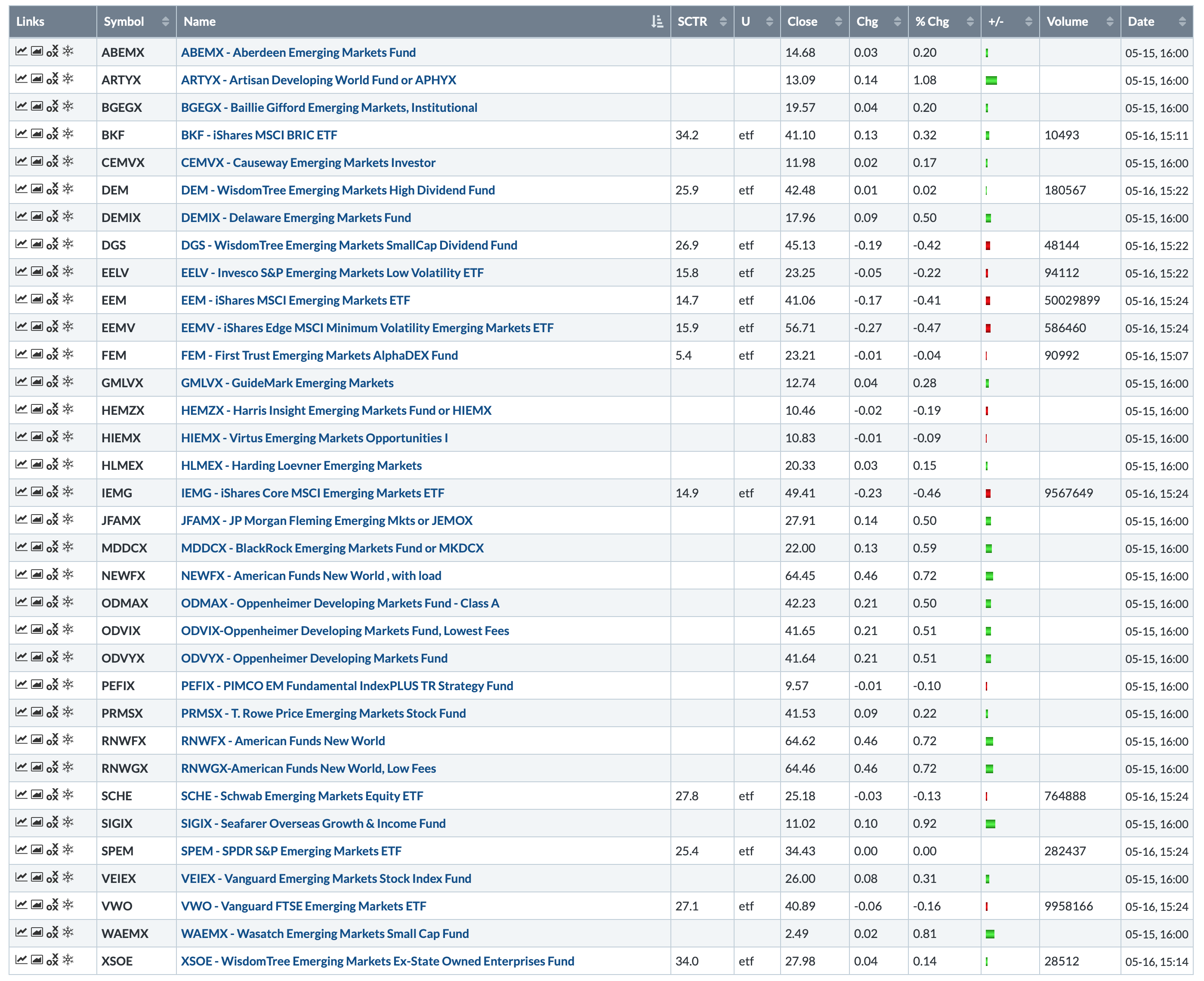
Trade well; trade with discipline!
- Gatis Roze, MBA, CMT
StockMarketMastery.com
|
| READ ONLINE → |
|
|
|
| DecisionPoint |
| Dissecting the Dow - New IT Price Momentum Oscillator SELL Signal |
| by Erin Swenlin |
This week, all four of the Scoreboard indexes (SPX, OEX, NDX, Dow) switched to IT Trend Model Neutral signals. This is just added insult to injury, given the ST Neutral and SELL signals that posted earlier this month. Today, the Dow lost its IT Price Momentum Oscillator (PMO) BUY signal. This occurs when the PMO crosses below its signal line on the weekly chart, as seen below.
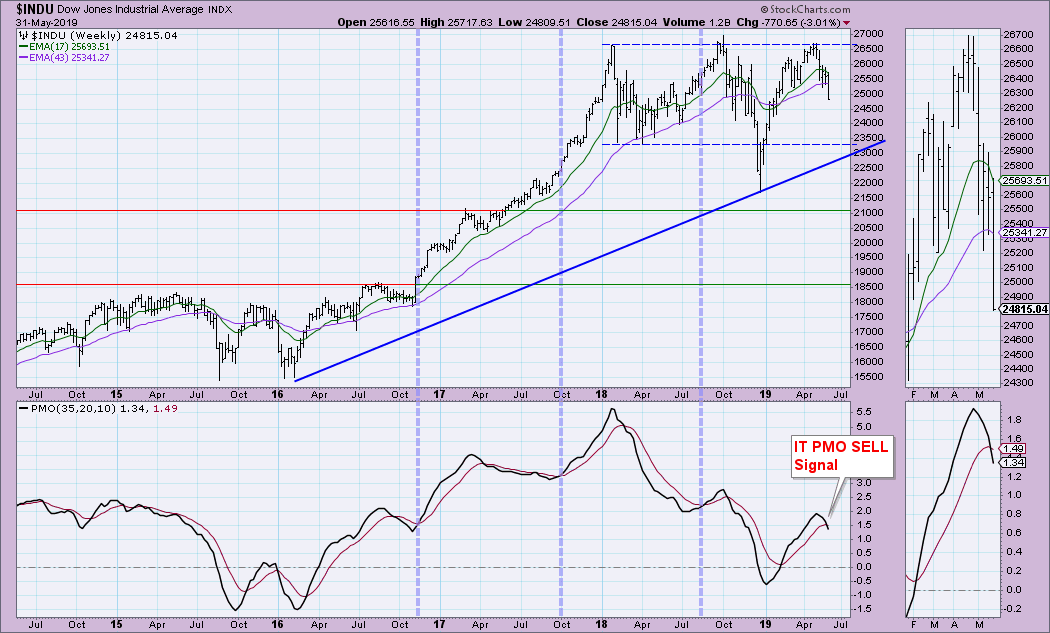
Here's a look at the DP Scoreboards. Carl wrote about the new IT Trend Model Neutral signal for the SPY in his Friday DP Weekly Wrap article. Be sure to read it, as there was also a SELL signal posted today on Oil.
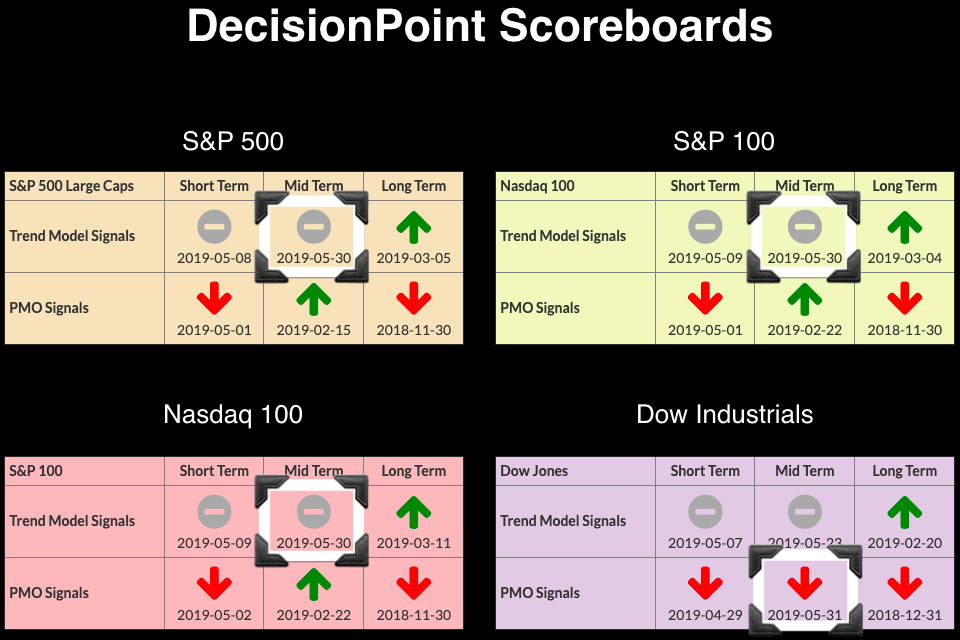
The Dow daily chart below points out the 20/50-EMA negative crossover that generated the Neutral signal. Despite a heavy-loss down day on the Dow, volume wasn't particularly climactic. I don't think this is over yet. In the chart, I've annotated a head-and-shoulders pattern. If you do the calculation by taking the length of the head to the neckline and subtracting it from the neckline, you would get a minimum downside target around 23600.
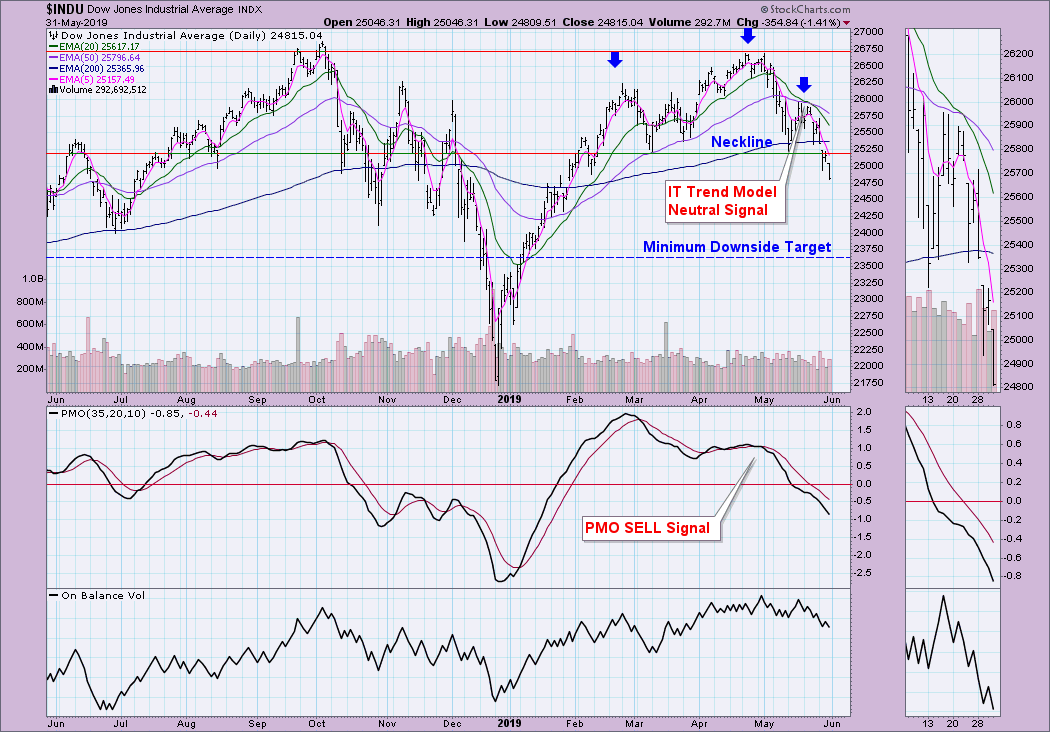 In the free DecisionPoint Straight Shots ChartPack in the Dow ChartList, we have the Swenlin Trading Oscillators and the ITBM/ITVM charts. Notice on the STOs below that oscillation above the zero line indicates strength and accompanies rallies. When we start to see climactic moves below the zero line, it is a sign of internal weakness. There is some hope; the STOs are very oversold, which usually means we'd see a reversal. However, it is important to note that these indicators stretched much lower during the bear market and could certainly do so now. In the free DecisionPoint Straight Shots ChartPack in the Dow ChartList, we have the Swenlin Trading Oscillators and the ITBM/ITVM charts. Notice on the STOs below that oscillation above the zero line indicates strength and accompanies rallies. When we start to see climactic moves below the zero line, it is a sign of internal weakness. There is some hope; the STOs are very oversold, which usually means we'd see a reversal. However, it is important to note that these indicators stretched much lower during the bear market and could certainly do so now.
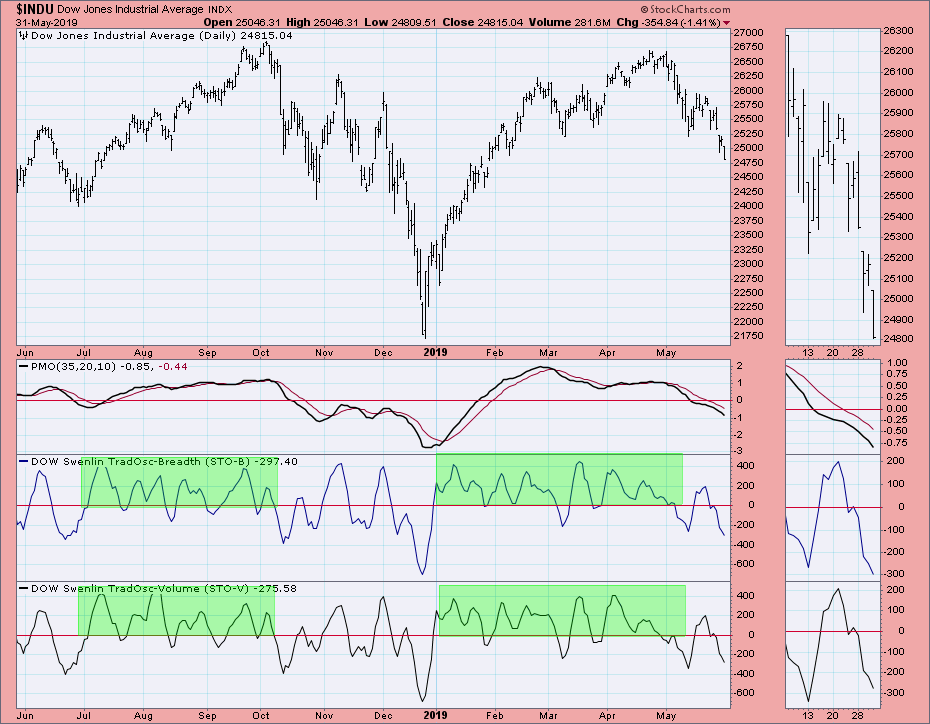
The ITBM and ITVM are very oversold for a bull market, but not so for a correction or bear market move.
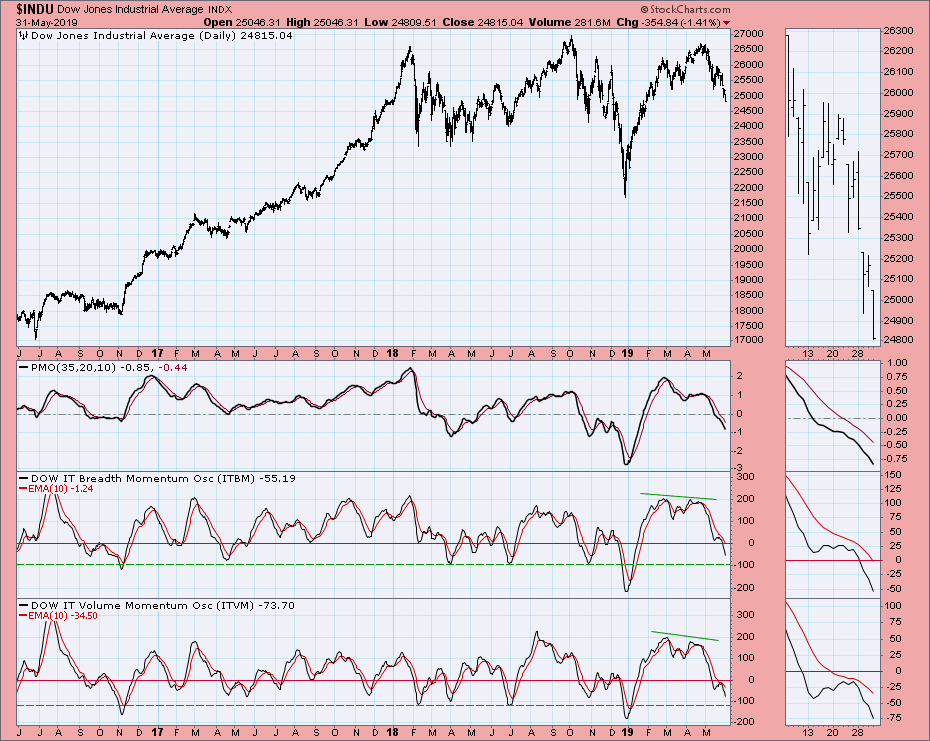
Conclusion: Indicators do not suggest a price reversal at this time. Take a look at the 20/50-EMAs on the SPDRs. We just logged ITTM Neutral signals for both XLK and XLY (aggressive sectors). The other sectors, including defensive sectors, are all headed for the same. Below is a CandleGlance. We are in correction mode now, and I don't see a price reversal on the horizon at this point.
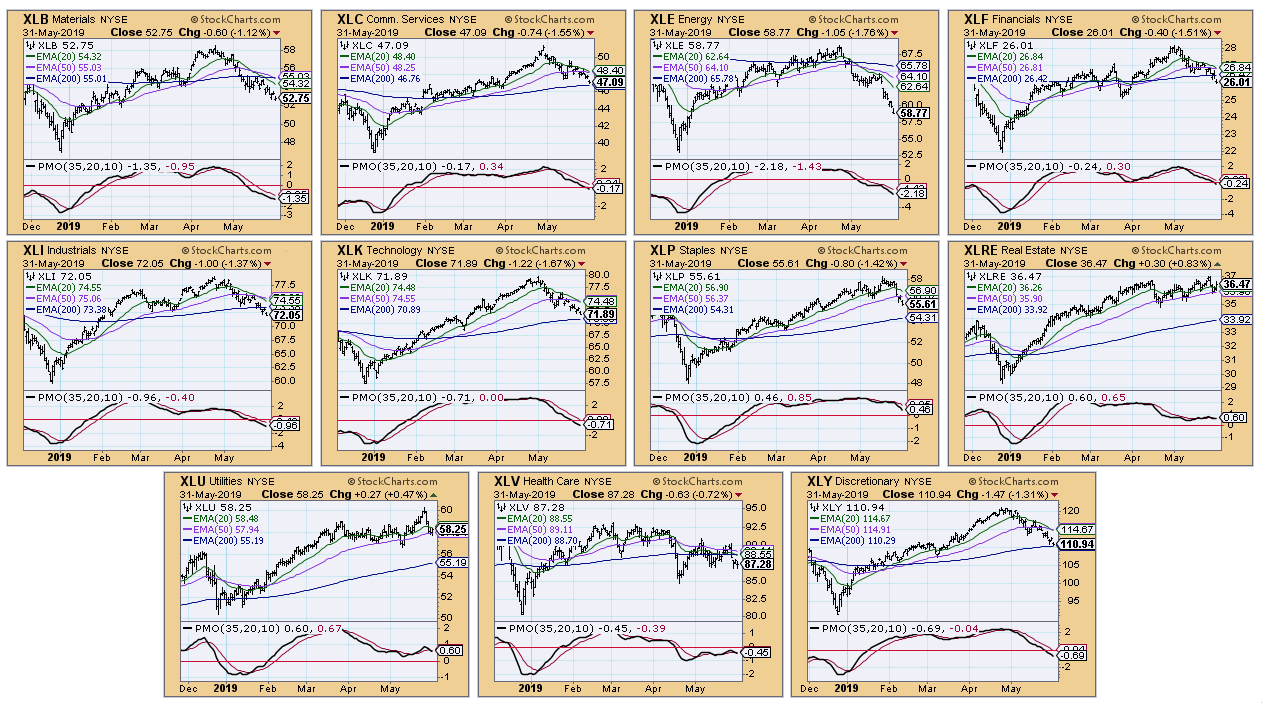
Watch the latest episode of DecisionPoint with Carl & Erin Swenlin LIVE on Fridays 4:30p EST or on the StockCharts TV YouTube channel here!
Technical Analysis is a windsock, not a crystal ball.
Happy Charting!
- Erin
erinh@stockcharts.com
Helpful DecisionPoint Links:
Erin's PMO Scan
DecisionPoint Chart Gallery
Trend Models
Price Momentum Oscillator (PMO)
On Balance Volume
Swenlin Trading Oscillators (STO-B and STO-V)
ITBM and ITVM
SCTR Ranking
**Don't miss DecisionPoint Commentary! Add your email below to be notified of new updates"**
|
| READ ONLINE → |
|
|
|
| The MEM Edge |
| The Relative Safety Of High-Yielding Stocks - 4 Names To Ponder As Interest Rates Plummet and Markets Waffle |
| by Mary Ellen McGonagle |
We’re in a difficult period with the markets at the moment, as uncertainty surrounding U.S.- China trade talks is weighing heavily on stocks. With both sides throwing barbs and a resumption of talks not due until later this month, the pressure on the markets may very likely continue.
With daily reactions to the latest trade-related headlines, there’s been an increased risk in equities, which, in turn, is pushing Interest rates down as investors seek the relative safety of U.S. Treasuries. In fact, yields are now down to levels not seen in over a year.
Income investors, as well as those looking to buffer their portfolios from any sharp gyrations in the U.S. Equity markets, may want to consider these four technically sound stocks, which can act to buffer you against continued volatility while providing growth prospects that should keep them attractive in the long run.
The first stock is in the Utility sector, which is hitting a new high in price. In addition to offering an attractive yield, Utility stocks don’t have exposure to China, which is another reason we’re seeing money flows into these defensive stocks.
Entergy (ETR) is a utility that delivers electricity to almost 3 million customers in the Louisiana/Texas area. The company made a strategic shift 5 years ago to enter the more regulated area of its industry; that move is now paying off with a bounce back to profitability in 2017, which has continued to expand since then. Given its growth prospects, this 3.7% yielder was touted as one of the few relative bargains among Electric Utilities by a major forecaster at this month’s Money Show.
As you can see in the chart below, the stock is in a confirmed uptrend, finding support at its upward-trending 10-day simple moving average following a breakout on a 2-month base. A quick look at the money flow characteristics tells us that this stock is poised for further outperformance.
DAILY CHART OF ENTERGY CORP. (ETR)
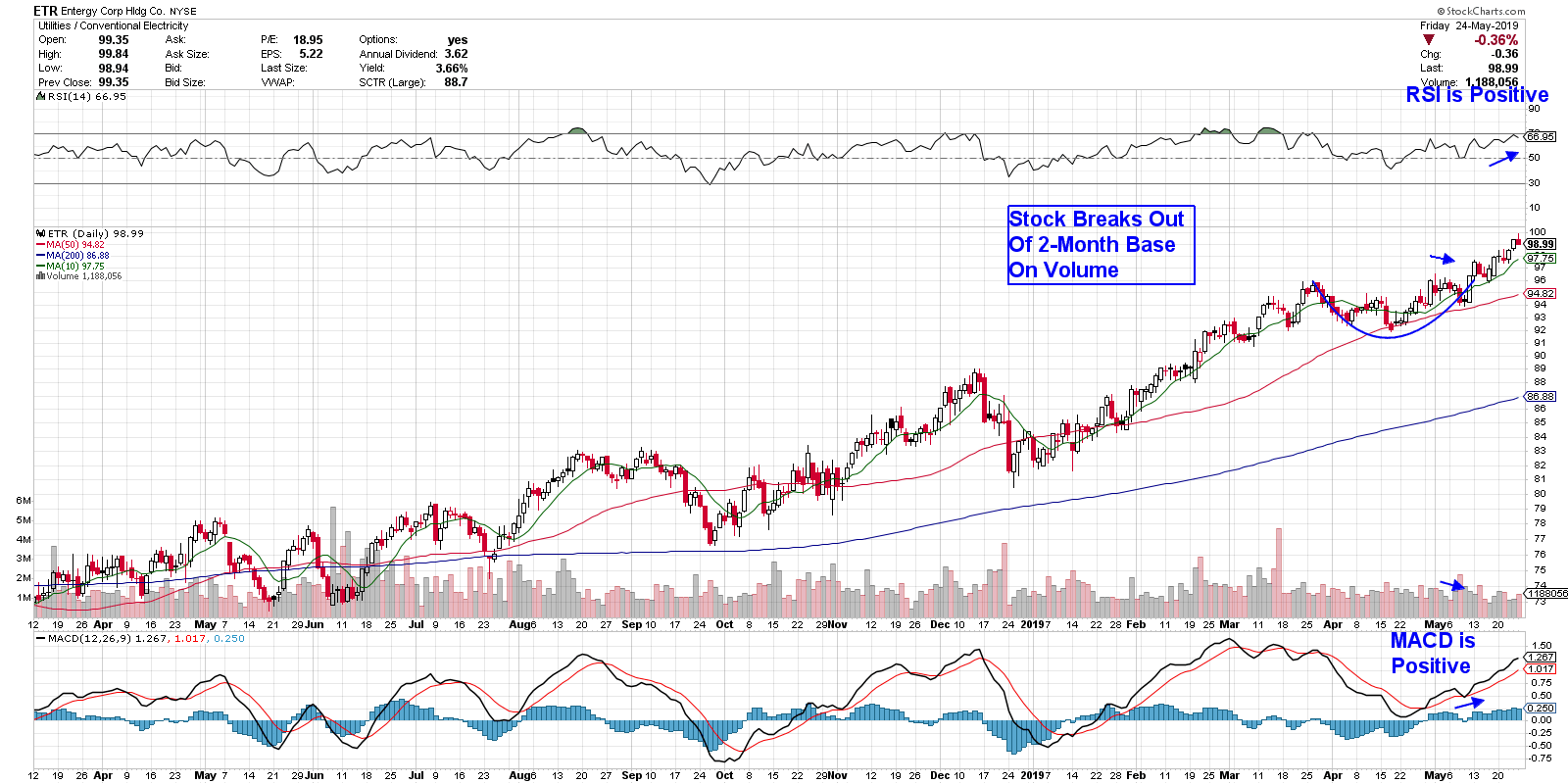
Our next stock is in the Consumer Staples. In addition to being in a defensive sector, this high yielder bought out a company that’s in an explosive growth area of the food industry, which should continue to help them grow.
That stock is General Mills (GIS). Although most investors may think that this 100-year old company is washed up, you may want to look closer. The company has been selling off some of their older, non-performing brands while simultaneously acquiring companies with new brands that appeal to evolving consumer tastes. One such company is Blue Buffalo, which produces and distributes premium food for dogs. The pet product industry is a $30 billion per year space and GIS is expected to participate heavily.
As you can see in the chart below, the stock hit a new high in price this week following positive remarks from a Wall Street analyst. This bullish move followed last week’s break out of a 1-month base. In addition, this 3.8% yielder remains in an uptrend as the stock continues to find support at its upward-trending 10-day moving average.
DAILY CHART OF GENERAL MILLS INC. (GIS)
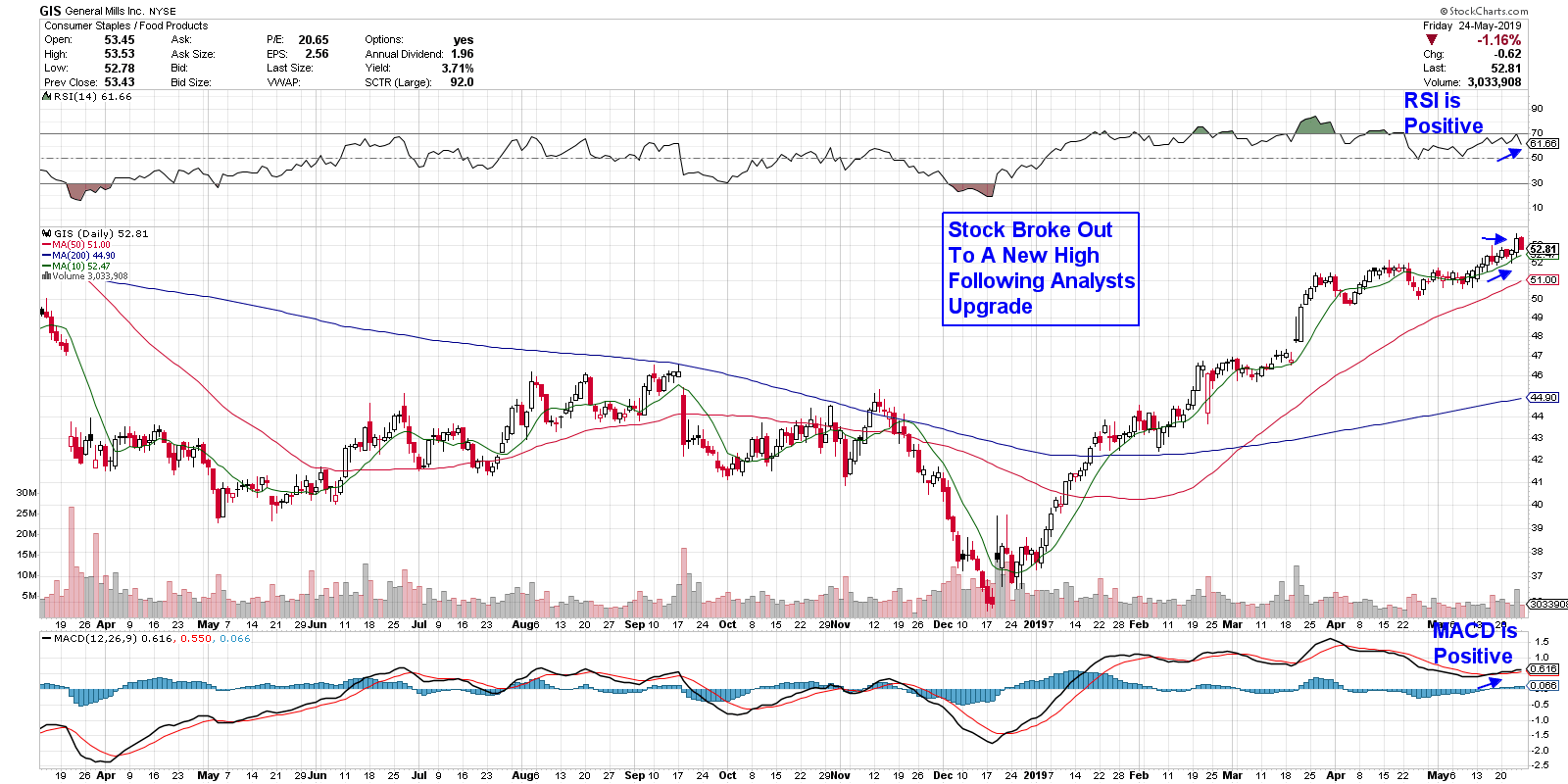
Next, we’ll turn our focus on a Real Estate related play, which is benefitting from an expanding economy as well as lower interest rates. The company we’re highlighting is one of the few truly diversified REIT (Real Estate Investment Trust) stocks, with properties spread across office, retail and industrial segments, as well as overseas properties.
The company is W.P. Carey (WPC) and this fast grower has managed to increase their annual dividend every year for 22 years running. Additionally, the company’s 5.2% yield is higher than most of its peers.
Currently, the stock is a bit extended following last week’s explosive move to a new high in price. As you can see on the chart below, a pullback to the 10- or 50-day moving average has historically presented itself as an ideal buying opportunity.
DAILY CHART OF WP CAREY INC. (WPC)
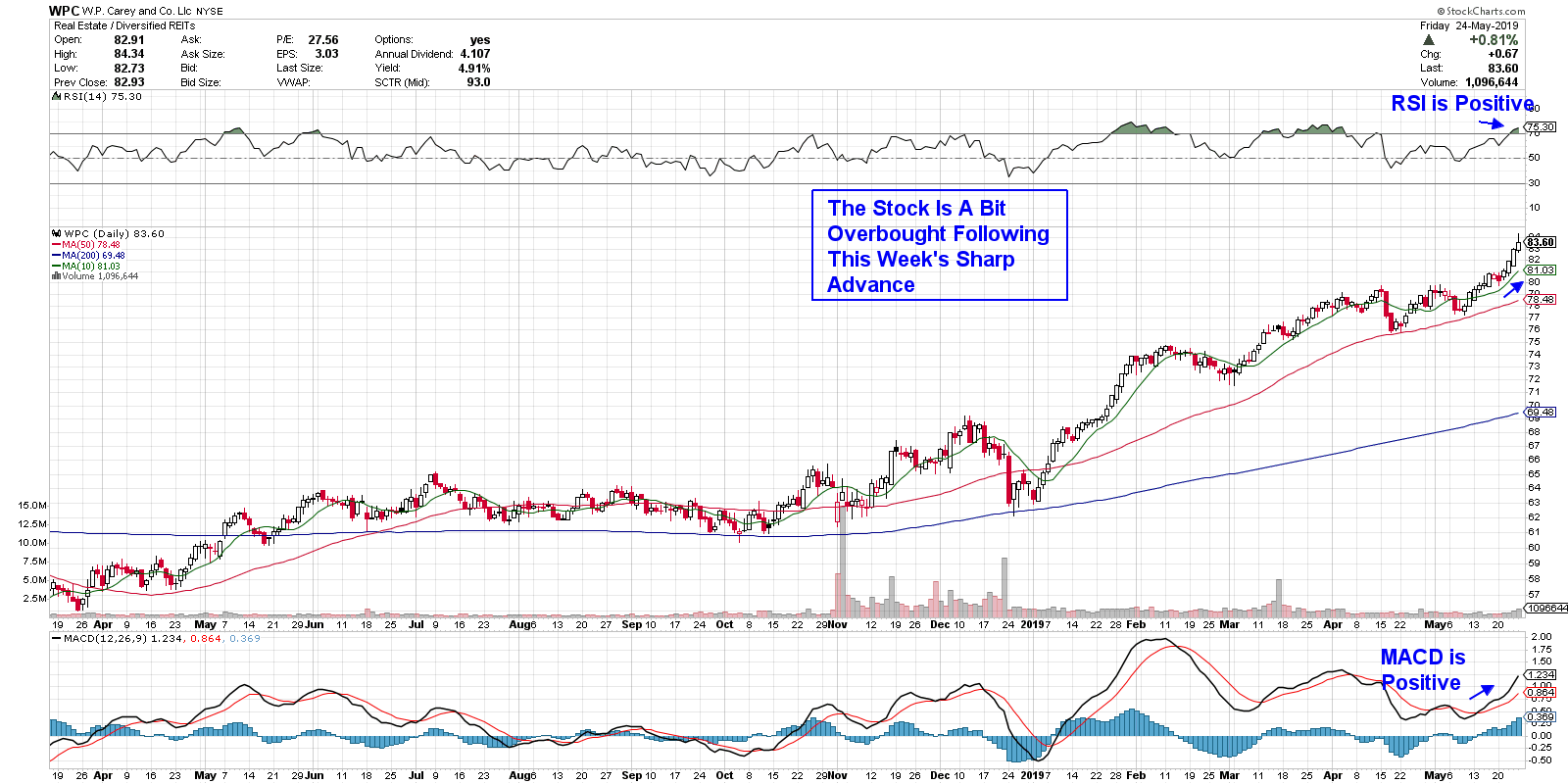
Lastly, I’ve highlighted an asset management firm that is reversing their recent downtrend with positive performance results, coupled with recent announcements that has analysts raising their guidance.
Ozh-Ziff Capital Management (OZM) is one of the largest alternative asset managers in the world, with over $32 Billion under management. Their main fund is consistently cited for outperformance relative to its peers, as it seeks investment opportunities in all asset classes and throughout the world. Of note is the company's late-December release of strategic policies that will restructure the company to create more visibility for shareholders.
The stock is currently in the throes of reversing a 5-year downtrend, as their new initiatives as well as favorable global market conditions begin to positively impact the company.
The daily chart below shows that the stock is in a clear uptrend as it continues to find support at its upward-trending 10-day simple moving average. In addition, both the RSI and MACD are positive. While the stock currently looks attractive, it’s important to note that it’s had an explosive run-up in May and, with a 29% gain for the month, we'd wait for a pullback before entering the stock. I would suggest buying on a pullback, as this 7.9% yielder appears poised for further outperformance.
DAILY CHART OF OCH-ZIFF CAPITAL MANAGEMENT (OZM)
 While my first three picks highlighted stocks that are in defensive areas of the market, which may outperform more during uncertain periods of the market, each of these companies has a growth prospect that should keep them attractive even after the market pressures lift. While my first three picks highlighted stocks that are in defensive areas of the market, which may outperform more during uncertain periods of the market, each of these companies has a growth prospect that should keep them attractive even after the market pressures lift.
Subscribers to my bi-weekly MEM Edge Report were alerted to these stocks a while ago. If you'd like a trial of this report, email me using the link below.
Warmly,
Mary Ellen McGonagle
MEM Investment Research
|
| READ ONLINE → |
|
|
|
| MORE ARTICLES → |
|


 Chart 1
Chart 1 Chart 2
Chart 2 The 200-day moving averages for the S&P Mid-Cap 400 and the S&P Small-Cap 600 are already trending lower and this key moving average for the S&P 500 turned lower over the past week. This puts all three indexes below their falling 200-day SMAs and in potential downtrends.
The 200-day moving averages for the S&P Mid-Cap 400 and the S&P Small-Cap 600 are already trending lower and this key moving average for the S&P 500 turned lower over the past week. This puts all three indexes below their falling 200-day SMAs and in potential downtrends.

 This was a key chart for me, as it represented the mega cap technology leadership that drove the market higher in the first four months of 2019. This trend line break was the most important in terms of acknowledging a potential sea change within equities.
This was a key chart for me, as it represented the mega cap technology leadership that drove the market higher in the first four months of 2019. This trend line break was the most important in terms of acknowledging a potential sea change within equities. The market has rarely gone meaningfully higher without semiconductors participating in the upswings. The SOX has broken trend line support and is now testing the 200-day moving average around 1320. A confirmed break below 1300 would suggest further lows and underperformance.
The market has rarely gone meaningfully higher without semiconductors participating in the upswings. The SOX has broken trend line support and is now testing the 200-day moving average around 1320. A confirmed break below 1300 would suggest further lows and underperformance. Microsoft is perhaps the least painful of the bunch, as it has broken the trend line a number of times but hasn’t really confirmed the break yet.
Microsoft is perhaps the least painful of the bunch, as it has broken the trend line a number of times but hasn’t really confirmed the break yet. Amazon has now confirmed a downside break of trend line support and is in the process of violating the 50-day moving average as well. The 200-day moving average looms large at around 1750.
Amazon has now confirmed a downside break of trend line support and is in the process of violating the 50-day moving average as well. The 200-day moving average looms large at around 1750. I love to use this ratio as a barometer of risk on vs. risk off within the consumer space. The ratio has confirmed a breakdown of the trend line and is now in an established downtrend. This suggests a rotation more toward the defensive side of the consumer sectors.
I love to use this ratio as a barometer of risk on vs. risk off within the consumer space. The ratio has confirmed a breakdown of the trend line and is now in an established downtrend. This suggests a rotation more toward the defensive side of the consumer sectors. I added this chart to the article in a later version because, although it represented a very different market than the other five charts, it was still a chart in a consistent uptrend that deserved attention.
I added this chart to the article in a later version because, although it represented a very different market than the other five charts, it was still a chart in a consistent uptrend that deserved attention.






 The market could remain highly volatile and, if it does, you will want to focus on stocks that are making money and headed higher for the future. These are the types of stocks traders are attracted to and should outperform the pack.
The market could remain highly volatile and, if it does, you will want to focus on stocks that are making money and headed higher for the future. These are the types of stocks traders are attracted to and should outperform the pack.
 A quarter century of investing yields one paramount conclusion. Venture capitalists have known this forever. Professional sports teams as well. Investors have been a little slower on the uptake.
A quarter century of investing yields one paramount conclusion. Venture capitalists have known this forever. Professional sports teams as well. Investors have been a little slower on the uptake.










 While my first three picks highlighted stocks that are in defensive areas of the market, which may outperform more during uncertain periods of the market, each of these companies has a growth prospect that should keep them attractive even after the market pressures lift.
While my first three picks highlighted stocks that are in defensive areas of the market, which may outperform more during uncertain periods of the market, each of these companies has a growth prospect that should keep them attractive even after the market pressures lift.







